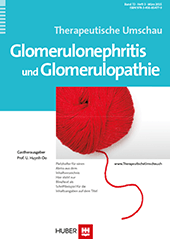Die fokal-segmentale Glomerulosklerose (FSGS): Im Jahr 2015 immer noch eine Herausforderung für die Nephrologen
Abstract
Die fokal-segmentale Glomerulosklerose (FSGS) ist eine häufige histologische Diagnose beim Erwachsenen mit nephrotischer Proteinurie und einer der häufigsten Gründe für eine terminale Niereninsuffizienz unter den primären Glomerulonephritiden. Das histologische Bild entspricht der histopathologischen Endstrecke vieler Glomerulopathien, bei denen es zum Nephronverlust mit funktioneller Überlastung der übrigen Nephrone kommt. Darüber hinaus tritt es bei angeborenen oder erworbenen Podozytenschädigungen auf. Die sekundäre Form der FSGS ist weitaus häufiger als die primäre idiopathische Form. Die Diagnose wird im klinisch pathologischen Kontext gestellt. Während die sekundäre FSGS sich klinisch meist mit über Jahren nur langsam progredienter Proteinurie und Nierenfunktionsverlust präsentiert, besteht bei der idiopathischen FSGS zum Zeitpunkt der Erstdiagnose meist eine manifeste Niereninsuffizienz und nephrotische Proteinurie, die rasch zur terminalen Niereninsuffizienz führt. Eine ätiologische Differenzierung der FSGS ist für die Therapie unabdingbar, da sich die Therapie der sekundären Form rein symptomatisch und wenn möglich kausal gestaltet, während bei der idiopathischen Form Immunsuppressiva zum Einsatz kommen. Nach einer Nierentransplantation besteht bei der idiopathischen FSGS eine hohe Rezidivneigung.
Focal segmental glomerulosclerosis (FSGS) is a common histological diagnosis in adults with nephrotic proteinuria and one of the most frequent causes of end stage renal disease (ESRD) among the primary glomerulopathies. Renal histology reveals the “endpoint” of most glomerulopathies, whereby nephron loss results in functional overload and further damage of the remaining ones. FSGS is thus the clinico-pathological manifestation of genetical and acquired damages to the podocytes. Secundary FSGS is much more frequent than the primary ones. While secondary FSGS is characterized by slow progression of proteinuria and decline of kidney function, idiopathic FSGS presents already at first manifestation with renal insufficiency and nephrotic proteinuria with fast progression to ESRD. An etiological definition of FSGS is crucial for its management, since treatment of secundary forms is only symptomatic and if possibly causal, while immunosuppression is indicated in the cases of idiopathic FSGS. Primary FSGS presents a high risk of relapse after kidney transplantation.



